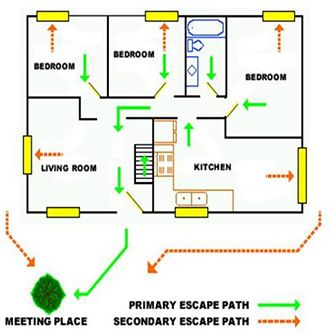ESCAPE ROUTES AND HOME FIRE DRILLS

The information below was reproduced from NFPA's Fire Prevention Week Web site, ©2003 NFPA.
Basic fire escape planning
Pull together everyone in your household and make a plan. Walk through your home and inspect all possible exits and escape routes. Households with children should consider drawing a floor plan of your home, marking two ways out of each room, including windows and doors. Also, mark the location of each smoke alarm.
For easy planning, download the FPW escape plan grid (PDF*, 464 KB). This is a great way to get children involved in fire safety in a non-threatening way.
Make sure that you have at least one smoke alarm on every level of your home.
Everyone in the household must understand the escape plan.
When you walk through your plan, check to make sure the escape routes are clear and doors and windows can be opened easily.
Choose an outside meeting place (i.e. neighbor's house, a light post, mailbox, or stop sign) a safe distance in front of your home where everyone can meet after they've escaped. Make sure to mark the location of the meeting place on your escape plan.
Go outside to see if your street number is clearly visible from the road. If not, paint it on the curb or install house numbers to ensure that emergency personnel can find your home.
Have everyone memorize the emergency phone number of the fire department. That way any member of the household can call from a neighbor's home or a cell phone once safely outside.
If there are infants, older adults or family members with mobility limitations make sure someone is assigned to assist them in the fire drill and in the event of an emergency. Assign a backup person too, in case the designee is not home during the emergency.
If windows or doors in your home have security bars, make sure the bars have quick-release mechanisms inside so that they can be opened immediately in an emergency. Quick-release mechanisms won't compromise your security - but they will increase your chances of safely escaping a home fire.
Tell guests or visitors to your home about your family's fire escape plan. When staying overnight at other people's homes, ask about their escape plan. If they don't have a plan in place, offer to help them make one. This is especially important when children are permitted to attend""sleepovers"" at friends' homes.
Be fully prepared for a real fire: when a smoke alarm sounds, get out immediately.
Residents of high-rise and apartment buildings may be safer ""defending in place.""
Once you're out, stay out!
Under no circumstances should you ever go back into a burning building. If someone is missing, inform the fire department dispatcher when you call. Firefighters have the skills and equipment to perform rescues.
Putting your plan to the test Practice your home fire escape plan twice a year, making the drill as realistic as possible.
Allow children to master fire escape planning and practice before holding a fire drill at night when they are sleeping. The objective is to practice, not to frighten, so telling children there will be a drill before they go to bed can be as effective as a surprise drill.
It's important to determine during the drill whether children and others can readily waken to the sound of the smoke alarm. If they fail to awaken, make sure that someone is assigned to wake them up as part of the drill and in a real emergency situation.
If your home has two floors, every family member (including children) must be able to escape from the second floor rooms. Escape ladders can be placed in or near windows to provide an additional escape route. Review the manufacturer's instructions carefully so you'll be able to use a safety ladder in an emergency. Practice setting up the ladder from a first floor window to make sure you can do it correctly and quickly. Children should only practice with a grown-up, and only from a first-story window.
Store the ladder near the window, in an easily accessible location. You don't want to have to search for it during a fire.
Always choose the escape route that is safest – the one with the least amount of smoke and heat – but be prepared to escape through toxic smoke if necessary.
When you do your fire drill, everyone in the family should practice crawling low on their hands and knees, one to two feet above the ground. By keeping your head low, you'll be able to breathe the ""good"" air that's closer to the floor.
It's important to practice crawling on your hands and knees, not your bellies, as some poisons produced by smoke are heavier than air and settle to the floor.
Closing doors on your way out slows the spread of fire, giving you more time to safely escape.
In some cases, smoke or fire may prevent you from exiting your home or apartment building. To prepare for an emergency like this, practice""sealing yourself in for safety"" as part of your home fire escape plan. Close all doors between you and the fire. Use duct tape or towels to seal the door cracks and cover air vents to keep smoke from coming in. If possible, open your windows at the top and bottom so fresh air can get in.
